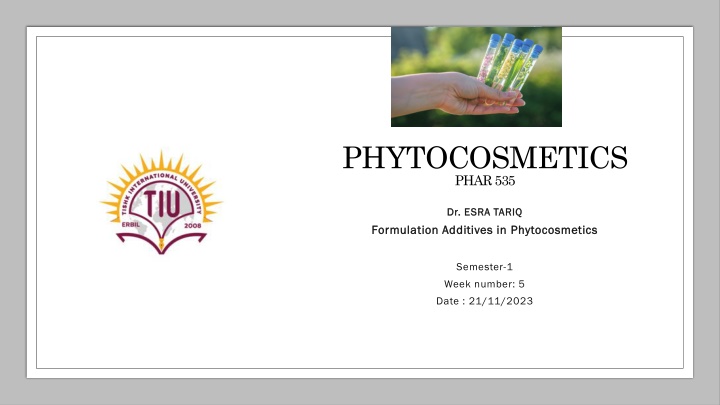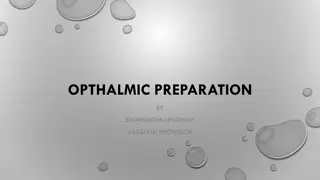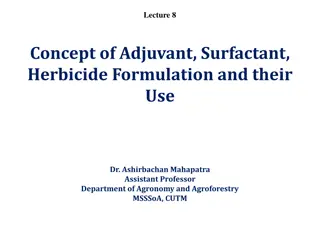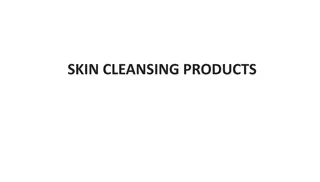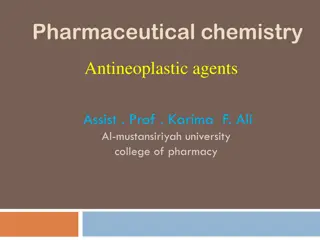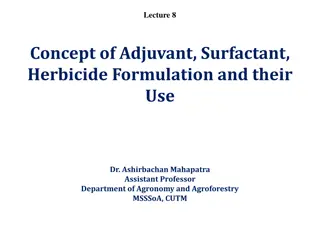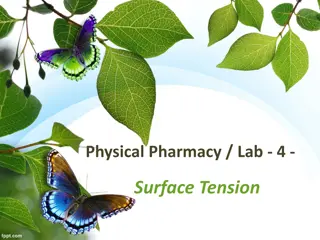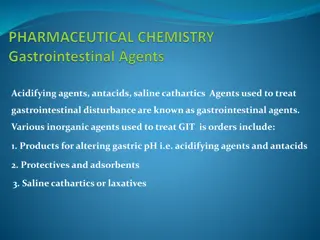Functions of Surfactants and Thickening Agents in Phytocosmetics
In Phytocosmetics, surfactants play a crucial role in formulating suspensions and emulsions, while thickening agents enhance the viscosity of topical formulations. Various natural surfactants like alkylglycosides and saponins derived from plant sources are utilized for their beneficial properties. Understanding the functions of these additives is essential for successful formulation in cosmetic science.
Download Presentation

Please find below an Image/Link to download the presentation.
The content on the website is provided AS IS for your information and personal use only. It may not be sold, licensed, or shared on other websites without obtaining consent from the author.If you encounter any issues during the download, it is possible that the publisher has removed the file from their server.
You are allowed to download the files provided on this website for personal or commercial use, subject to the condition that they are used lawfully. All files are the property of their respective owners.
The content on the website is provided AS IS for your information and personal use only. It may not be sold, licensed, or shared on other websites without obtaining consent from the author.
E N D
Presentation Transcript
PHYTOCOSMETICS PHAR 535 Dr. ESRA TARIQ Dr. ESRA TARIQ Formulation Additives in Formulation Additives in Phytocosmetics Phytocosmetics Semester-1 Week number: 5 Date : 21/11/2023
Outline Surfactants (Surface active agents) Functions od Surfactants in Phytocosmetics Thickening/Suspending Agents Functions of Thickenners
Surfactants in Phytochemical groups of plants Surfactants/ Surface Active Agents are the ingredients used to formulate several suspensions, and emulsions in cosmetic technology. They are added to aqueous solutions to increase solubility of lipophilic substances and hence they have ability to increase lipid absorption through the SC. Because akylglycosides or fatty alcohol glycosides are biodegradable, non-toxic and non- irritant surfactants, they are widely used in industry of cosmetics and detergents.
Surfactants in Phytochemical groups of plants Alkylglycosides have been isolated from the fruit of acerola (Malphigia glabra), the essential oil of the dried leaves of oregano (Origanum vulgare), the methanolic extract of cumin fruit (Cuminum cyminum), the fruit of bupleurum (Bupleurum falcatum), and the aerial parts of the sage plant Phlomis lunariifolia. Other natural surfactants of great interest are fatty acid (FA) amides, such as ceramides, anandamide, oleamide, N-arachidonoyldopamine, and N-acylethanolamine. These compounds generally have high biological properties. For example, N- palmitoylethanolamine is an anti-inflammatory contained in soybean and peanut oil. FA amide glycosides, such as gangliosides, aminoglycosides, and their derivatives, also show biological activities.
Surfactants in Phytochemical groups of plants Other surfactants include carotenoid glycosides, isoprenoid glycolipids, and terpenoids. Saponins are glycosides of triterpenes, steroids, or steroid alkaloids with high surfactant properties. These compounds derive their name from the soapwort plant (Saponaria officinalis), the roots of which have been traditionally used as a soap. Other well-known botanical sources of saponins include ginseng (Panax ginseng), the roots of licorice (Glycyrrhiza glabra) and butcher s broom (Ruscus aculeatus), and the seeds of horse chestnut (Aesculus hippocastanum).
Thickening Agents Viscosity-increasing, thickening agents are frequently used in topical formulations. These materials serve the purpose of producing solid cosmetics or rendering suspensions, emulsions, or ointments more easily spreadable and appealable, and improving skin moisturizing, emolliency, and absorption characteristics. According to the type of formulation, aqueous or oily thickening agents, or a mixture thereof, have to be used.
Thickening Agents Most common natural aqueous thickening agents include polysaccharides such as carrageenan; a sulfated polysaccharide extracted from red seaweeds, glucomannan, which is present in aloe gel and is particularly abundant in the corm of the konjac plant (Amorphophallus konjac); xanthan gum, a bacterial product obtained from fermentation processes operated by Xanthomonas campestris; guar gum, a galactomannan obtained from guar (Cyamopsis tetragonoloba) beans; and carob gum, a galactomannan extracted from the seeds of the carob tree (Ceratonia siliqua)
Thickening Agents Components of plant cell walls are also commonly used as viscosity enhancers, such as pectin, a main source of which are citrus fruits, and cellulose, mostly employed in the form of its derivatives, like methylcellulose and hydroxyethylcellulose, which do not occur naturally but are synthesized starting from plant material. Proteins are also used as aqueous viscosity enhancers, usually gelatin, which is obtained from the collagen contained in by-products of the meat and leather industry. Examples of natural oily thickening agents include waxes, such as carnauba wax, derived from the leaves of the carnauba palm (Copernicia prunifera), and beeswax produced by honey bees (Apis mellifera).
Penetration Enhancers Penetration enhancers generally act on the stratum corneum, and their possible mechanisms of action include the reduction of the skin permeability barrier via the disruption of the tightly packed lipid regions, They induce modification in the skin texture, especially in the stratum corneum, which can lead to irritation or other injurious effects to the skin, and should always be used after careful testing. Water exerts a very poor penetration-enhancing activity as an external agent, while there is more efficient approach consists in the use of occlusive materials or patches, which increase the amount of water in the stratum corneum by preventing transepidermal water loss: Ethanol, Urea..
Penetration Enhancers Ethanol and Urea as penetration enhancers Ethanol is commonly used to increase the solubility of a drug in the vehicle and in transdermal formulations, and is often the solvent of choice for use in patches. Urea is acting by increasing the water content of the stratum corneum and exerting keratolytic activity.
Penetration Enhancers The essential oils of: Eucalyptus (Eucalyptus globulus), Wormseed (Chenopodium ambrosioides), and Ylang ylang (Cananga odorata) have been tested as penetration enhancers in vivo. As Volatile oil: Such a kind of activity in volatile oils is mainly due to the presence of various terpenes and terpenoids. These compounds operate by modifying the solvent nature of the stratum corneum, improving drug partitioning into the tissue.
Preservatives Various methods of preservation are available to the formulators of cosmetic preparations, in order to prevent alteration and degradation of their products. Due to the toxicity properties of many preservatives, their application and selection are strictly defined by legal rules in many countries. Methods of preservation, botanicalmaterials and natural molecules offer different possibilities of use.
Preservatives Plant natural preservatives, also known as phytoalexins, frequently possess other biological effects besides their antimicrobial properties. Components of natural preservatives: Terpenoids, organic acids, oxygenated fatty acids, aliphatic alcohols, polyols, and polyphenols. Examples for natural preservative compounds: Essential oils such as Glyceryl monoesters, such as glyceryl caprylate Benzoic acid/ Benzyl alcohol Alkyl esters of p-hydroxybenzoic acid (parabens) Vitamin A, retinoic acid, -carotene,Vitamin C, and E
Preservatives Among natural antioxidants, phenolic compounds are in the forefront since they have the structural requirements of free radical scavengers. Various phenolic classes can be used for this purpose, including phenolic acids, anthocyanins, cathechins, hydroxycinnamic acid derivatives, and flavonoids
References Peter Elsner, (2000). Cosmeceuticals , Drugs vs Cosmetics, Marcel Dekker, Inc. New York Basel TM Bruno Burlando, Luisella Verotta, Laura Cornara, Elisa Bottini-Massa, Herbal Principles in Cosmetics: Properties and Mechanisms of Action, 2010, CRC Press.
